Liriope muscari goes by many names — sometimes people call it Liriope, lily turf, or most often, monkey grass. But this perennial ornamental grass has little in common with primates; the plant actually comes from the lily family. Gardeners will find it quite versatile. “In warm-winter areas, it tends to be evergreen; in colder climates, the foliage may die back in winter,” said horticultural craftsman Justin Hancock to Martha Stewart. He also added that to freshen up the plant’s look, you merely take your lawnmower, set it on the highest setting, and simply mow over it. Then, presto, new foliage appears.
Monkey grass can reach 10 to 18 inches high, and the result is a beautiful carpet-like border that can frame your garden with charming white, pink, or purple flowers. They blossom from July to August, popping up through the green, according to Gardening Know How. Some monkey grass like the Liriope spicata spreads aggressively, so you can fill in an empty hillside fairly quickly with it. Those varieties are better for ground cover than in a garden since it will choke out all the other plants.
However, the best part of monkey grass, no matter what variety you use, is that once it’s planted there’s little to do; the grass is drought tolerant, pest resistant, requires no or little fertilizer, and only needs mowing annually. If only maintaining our lawns could be as easy as working with monkey grass.
How to grow monkey grass
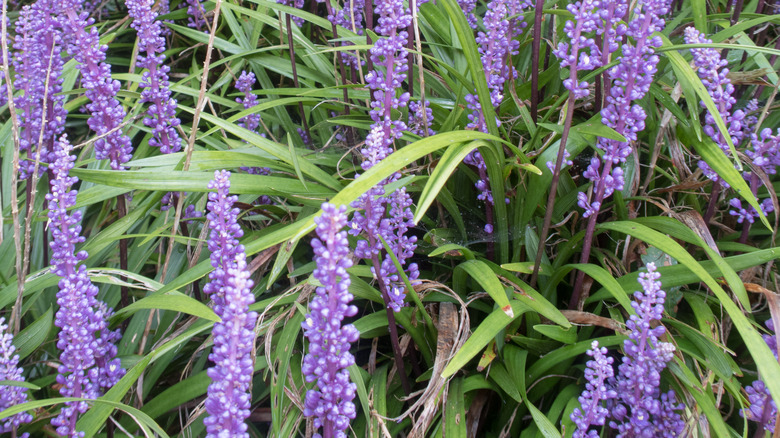
You’ll see a theme forming with monkey grass … it’s easy to grow. It does well in USDA zones 7 through 11 and its hardiness just necessitates that you water it occasionally. Since the plants grow well, you’ll don’t need much to start; just purchase monkey grass seeds or starter packs from your local nursery, advises Garden Beast.
Plant monkey grass in the spring after the final frost disappears. You want to help foster the plant while the roots set into the soil. Weeds might hinder your success so putting some mulch around the plant’s base can help. When planting, dig at least 18 inches — that depth will help drain excess water away from the roots. Monkey grass is susceptible to root rot and other diseases; it is essential that you don’t over water the plant.
You can add some organic compost before installing the monkey grass — this will give the soil a bit of an acidic pH, which will make the plant happy. Make sure you leave about 6 to 8 inches of space between plants, as monkey grass needs room to grow. You can put a few drops of diluted liquid fertilizer during the early spring, but monkey grass is tough so it is not essential.
How to care for monkey grass
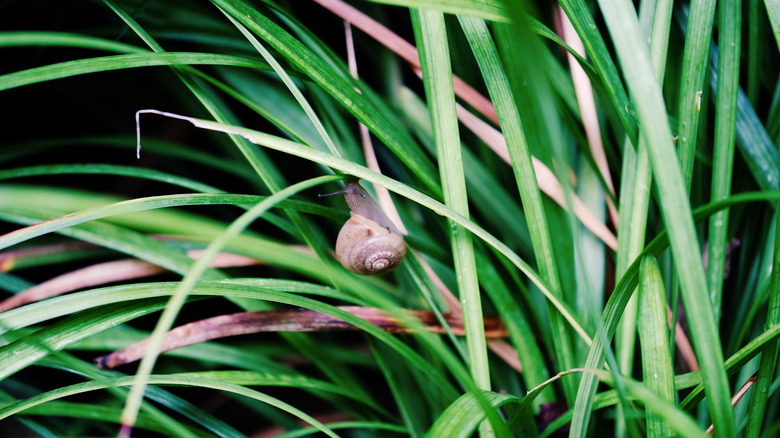
Once again, you really have it made with monkey grass, as it doesn’t need constant attention or fertilizer. Generally, once the grass is planted, you just let it grow. It does have a few natural enemies: slugs and snails like the foliage and will nibble on it. But they rarely harm the monkey grass. Just remove any that you see, and if they seem to hurt the plant, buy a few slug traps. Be sure to check after a rainfall, which attracts the little buggers, according to HGTV.
Sometimes too much water hurts monkey grass, and can lead to a fungal condition called anthracnose infection. You’ll see that the tips of the leaves will turn brown and then yellow. Monkey grass can also get leaf rot, root rot, and crown rot — all due to too much moisture. This is why it’s so essential to plant monkey grass in well-drained soil and to opt out of any device that does overhead watering; instead use a tool that focuses on the roots, such as drip irrigation.
Varieties of monkey grass
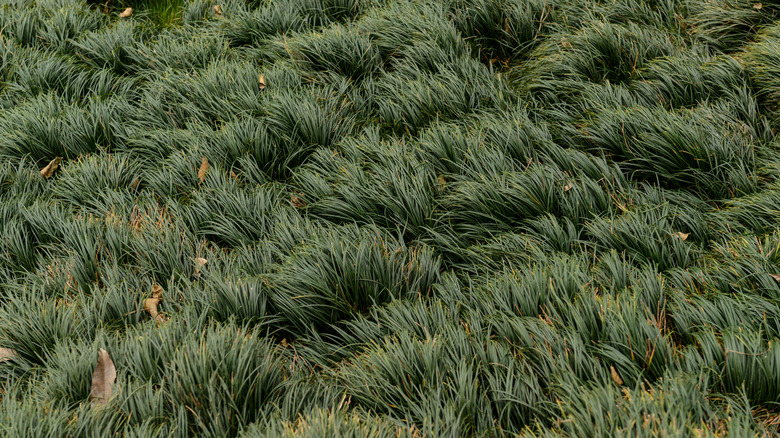
Shutterstock
Monkey grass comes in several varieties, and there seems to be one for every need. Want a grass that thrives in the shade? Got that. Need heavy clumps of grass so no weeding is required? Check. Looking for something that creeps all over that empty plot in your backyard? Done.
Monkey grass falls into two types: Liriope or Ophiopogon.
- Liriope like partial sun to full shade and work in most soils. They grow from 10 to 15 inches tall and include the following types:
- Liriope muscari: a clumping version that works well for edging, suggests Southern Living. These include Variegata that enjoys sun or partial shade, and Big Blue, a fave for gardeners looking for plants that thrive in sun and partial shade. They bloom spikey purple flowers in the late summer (both in USDA zones 5 to 10).
- Creeping liriope or Liriope spicata grow quickly and can cover a big space or hill easily. For instance, Silver Dragon spreads between 8 and 18 inches and can grow as high as 18 inches in USDA zones 4 through 10, per HGTV.
- Mondo grass (see photo above) or Ophiopogon japonicas enjoys partial sun to full shade as well, but prefers well-drained soils. Heights depend on type of grass, and vary from 2 to 12 inches. These include:
- Gyoku Ryu, which works well for coverage between stepping-stones since it grows slowly and stays close to the ground.
- Black mondo grass or O. planiscapus Nigrescens looks nice in containers.
Is monkey grass toxic?

Shutterstock
Some believe that monkey grass is toxic to humans and animals. With the invasiveness of some of its varieties that choke out all other plants from the garden, it can seem that monkey grass is a plant not to grapple lightly with. While some pet owners might say that their cat or dog had a stomachache or vomiting after binging on it, there is reportedly no evidence that shows the plant is poisonous — at least, no more harmful that indulging on too much backyard grass is. Just like anything else, according to gardening expert and author Walter Reeves, quoted in Hunker, it can “cause stomach upset when consumed in large quantities.”
So whether the plant’s seeds, leaves, or roots get eaten? All of it won’t hurt humans or their furry best friends. At the worst, those that binge on it will get a mild stomachache … and really, aren’t there more delicious things out there to consume than some thick grass?
How to transplant monkey grass
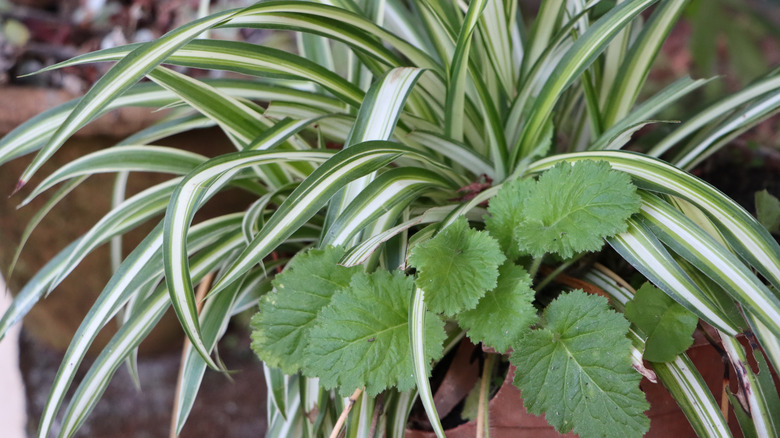
Shutterstock
Besides being one of the easiest plants to maintain in your garden, monkey grass also can save you money. That’s right, the plant multiplies so well that essentially, you can create others of the perennial plant for no cost, said The Gardening Cook. All you need to do is dig up the runners and plant those in a more sparse part of your garden. The plant, in turn, sends out more runners that help propagate the grass.
Just like the initial planting when monkey grass requires a little TLC, the same is true for transplanting it. You want it to root firmly. That’s why Gardening Know How suggests pulling out any extra growths that might impede the grass connecting to the earth and forming a thick spread. This takes time, so don’t transplant monkey grass any later than midsummer. Remember, too, that monkey grass is aggressive so be sure to put it in places that won’t reduce your entire garden to grass. It works well as ground cover (under bushes or on slopped areas), as a border for flowers, and is great to edge pathways or stepping-stone areas.
Does monkey grass attract mosquitoes?

Encierro/Shutterstock
According to the North Carolina Native Plant Society (NCNPS), Liriope spicata is indeed known to be an ideal habitat for mosquitoes. The very thick, moist ground cover is exactly the curb appeal most favorable to house-hunting mosquitoes. Unfortunately, spraying your yard for mosquitoes harms all insects — even the beneficial ones. Fortunately, there are alternatives! Evergreen Pest Control suggests some plants you can strategically place in your yard that work as mosquito repellents. That is, if you happen to be fond of your monkey grass and don’t want to kill everything alive in your yard. There are scents that emanate from certain plants that seem to offend mosquitoes particularly.
Some plants that do this job nicely are things like lavender, basil, rosemary, lemon balm, catnip (think twice before planting this one), marigolds, and ageratums. Lovely smelling and delicate, lavender is a great addition to any landscaping and can be grown indoors or outdoors. Basil is a simple plant to grow that you can easily harvest and use in your own kitchen spice collection. Lemon basil or cinnamon basil are the best repellents. Rosemary is also easy to grow, doesn’t require much water, and makes a great border plant. Lemon balm works as well or better than having citronella candles, since the leaves contain large amounts of citronella compounds. BUT, be careful with this one and grow it in a pot, as it is fast-growing and self-propagating. Catnip, of course, will attract the neighborhood cats, but if you don’t think that will be a problem, this one has been proven to be more effective than DEET — the main ingredient in most mosquito and bug repellents. Marigolds contain pyrethrum, and ageratums contain coumarin — both ingredients in bug repellents — and work like charms while looking beautiful!
When and how to prune monkey grass
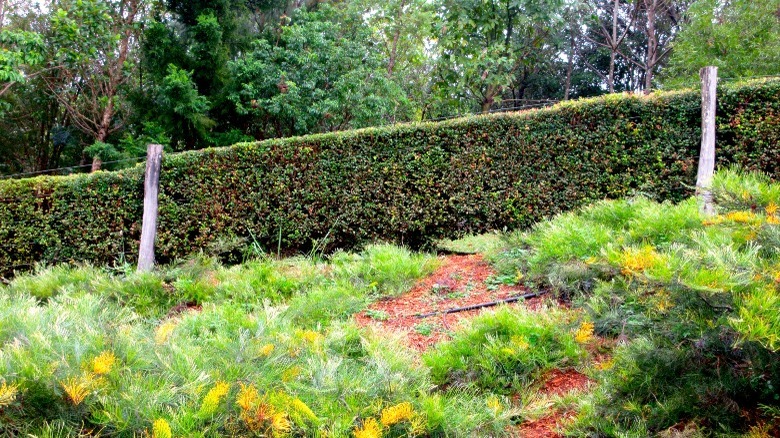
Jen Petrie/Shutterstock
Ok, so let’s talk haircuts. If you’re using liriope or monkey grass for ground cover, it’s natural to want to know when you should give it a trim. According to NOLA, this variety of ground cover is convenient because you only need to prune it every two to three years. The evergreen plant should be pruned towards the end of winter, like in February, before new spring growth starts. You should begin with garden scissors, string trimmers, hedge shears, or your lawnmower. If you use the mower, put it to the highest setting control, and if the blades need sharpening, do this first. Push the mower slowly but firmly through the monkey grass cover. It’s a good rule of thumb to do this when the liriope has cold damage or old, damaged foliage mixed in with the new growth, and generally appears disheveled and in need of a thorough grooming.
Arbor-Nomics Turf explains if you’re using a hand-trimming tool, cut the leaves or blades back to about 3 inches long. It also reminds us that liriope is very simple to grow and hardly requires any water. It’s green all year round in most cases, and is drought and heat-resistant. It can thrive in many climates and conditions and doesn’t typically suffer from foot traffic, diseases, animal damage, or insect damage. Keep in mind, however, the liriope is an invasive species, and Liriope spicata, in particular, can easily get away from you. According to the Fairfax County Park Authority, both species of monkey grass are on invasive watchlists in many locations, so check with your local agriculture authorities to ensure you won’t be breaking the law by planting, propagating, or spreading the population of this species.



